A powerhouse for research just got even stronger.
Designed to Empower and Improve Everyday Lives
The Grand Challenges Research Building is designed to address society’s most pressing challenges in areas including engineering, medicine, planetary science, and optics. This state-of-the-art space supports the expansion of the Optical Sciences and the U of A-led Center for Quantum Networks.
Reserve a room at GCRB
Rooms in GCRB are reservable for events and meetings related to UA research endeavors.
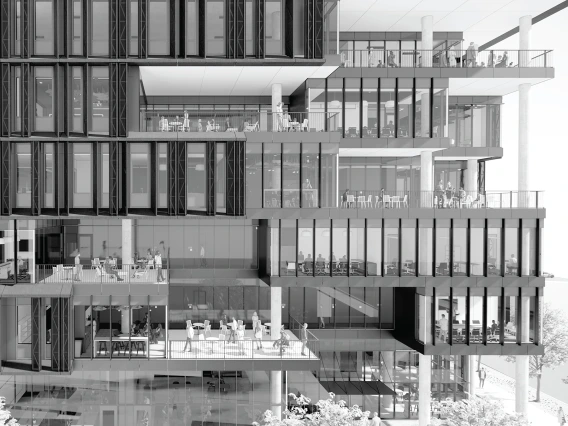
A brighter future starts here.
The Grand Challenges Research Building is designed to address society’s most pressing challenges in areas including engineering, medicine, planetary science, and optics. This state-of-the-art space also supports the expansion of the Optical Sciences and the University of Arizona led Center for Quantum Networks.
Step into the Grand Challenges Research Building.
- The seven-story, 115,000-square-foot interdisciplinary space is designed to promote a culture of collaboration and innovation, featuring public spaces, study areas, meeting rooms, and laboratories and offices to support faculty and student engagement in cutting-edge research.
- This facility will leverage and amplify the University of Arizona’s greatest core research strengths in the areas of engineering, optical science, lunar & planetary science, medicine, and much more.
- In this building, world experts from a range of growing and cutting-edge fields will come together with students to make discoveries and to teach the next generation of scientists, doctors, entrepreneurs and engineers.
Fun Fact
According to a 2024 Rounds Consulting Group report, quantum initiatives at the University of Arizona will create new high-paying jobs and generate more than $220M in economic activity over the coming decade.

Arizona Quantum Initiative (AQuI)
The Arizona Quantum Initiative (AQuI) is positioning Arizona as a global leader in quantum information science and engineering. The AQuI community includes leading University of Arizona faculty from Optical Sciences, Engineering, Physics, Mathematics, Chemistry, Data Science, and Law, along with their respective research groups.
Research and Applications
- Center for Quantum Networks (CQN): With academic partners, including MIT, Harvard, UMD, UMass, and over twenty industrial partners, CQN is revolutionizing how data is communicated across the globe.
- Tucson Quantum Network System Testbed: A campus-wide quantum network testbed with multi-user, high-rate entanglement, distribution to test silicon photonic chips, mature new technologies, demonstrate novel protocols, and serve as a state-of-the-art facility for education.
- New Master of Science Degree: Educating the quantum workforce of tomorrow in Quantum Information Science and Engineering (QISE), an entirely new discipline with a curriculum developed by CQN.
Fun Fact
Quantum networking relies on the principles of entanglement where two particles can become linked, so that the state of one instantly influences the state of the other, no matter how far apart. Often described as “spooky action at a distance,” this phenomenon enables ultra-secure communication methods where eavesdropping would be detectable!

Biomedical Informatics & Biostatistics (CB2)
The Center for Biomedical Informatics & Biostatistics (CB2) at University of Arizona Health Sciences drives innovation in biomedical research and healthcare by bringing together informatics, AI, data science, and biostatistics.CB2 empowers U of A researchers to advance medical science and improve health outcomes by providing access to health and biomedical data, specimen management, research data management, customized research applications, study design, advanced analytics, and computation.
Research and Applications
- Wearable Technology: Combining wearable sensors and real-time analytics for applications ranging from athletic training to pregnancy monitoring.
- Honest Broker: Facilitating access to health data from many sources including Banner Health, Medicaid, health insurance claims, and population health data.
- Common Data Elements: Defining national standards for clinical trial data collection to improve rigor, reliability, and reproducibility.
Fun fact
It is nearly impossible to determine the function of a particular gene variant if everyone in a population shares the same variant. The unique genetic diversity in our local population makes Arizona a valuable place for studying the effects of genes on health and disease.
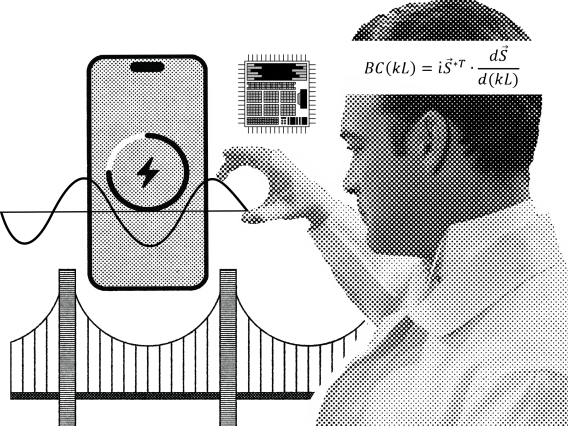
New Frontiers of Sound (NewFoS)
Established in 2023 with a $30 million grant from the National Science Foundation, the New Frontiers of Sound (NewFoS) Center is poised to revolutionize technology, transform everyday life and create a more sustainable tomorrow. Partnering with eight top-tier institutions, including Caltech, UCLA, and Georgia Tech, the center conducts cutting-edge research in topological acoustics—a new field which exploits the complete range of acoustic wave properties.
Research and Applications
- Advanced Data Processing: Using the similarities between how sound waves behave and how particles act in quantum mechanics to process large amounts of data more quickly and accurately for the toughest computational challenges
- Telecommunications: Reducing power consumption and cost, improving battery life, and increasing speed and functionality for electronic devices with technologies for 6G and beyond
- Environmental and Structural Sensing: Using acoustic waves to detect wear and flaws in structures as well as seismic waves for tracking environmental changes, such as soil dryness or permafrost thaw
Fun Fact
Sesimic waves—sound waves propagating in the ground—can travel at speeds up to 13,000 miles per hour through Earth’s crust! These waves, generated by earthquakes, help NewFoS scientists remotely and continuously monitor changes in the ground to help predict and prevent damage from the changes of the Earth’s surface due to climate change.
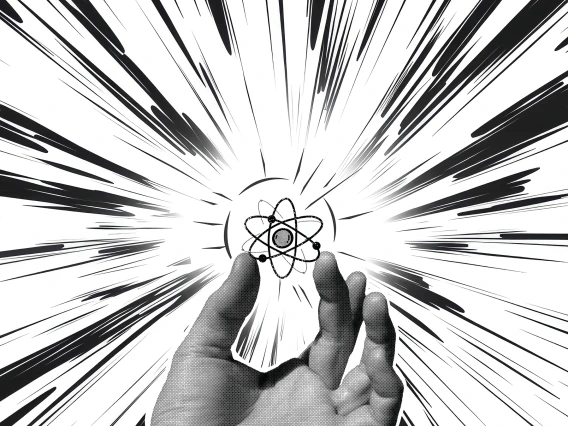
Optical Sciences
The University of Arizona Wyant College of Optical Sciences is one of the premier educational and research institutions for optics and photonics. Faculty and students lead advances in the field, including fundamental optical physics, astronomical and space optics, quantum sensing and networking, biomedical imaging, optical fiber communications, semiconductor manufacturing, and optics for national security and consumer display markets.
Research and Applications
- Sensing gravity and acceleration: Inertial sensors crafted using micro-electronics fabrication technologies harness the interaction of lasers with tiny vibrating mechanical systems to provide unprecedented sensitivities for use in precision manufacturing, astronomy, and other cutting-edge fields.
- Powerful cameras for cancer detection: The mobile intraoral camera boosts oral cancer detection accuracy from 40-60% to 87-93%. Once detected, the most dangerous areas are biopsied for more precise diagnosis and treatment.
- Developing sensor systems for defense: Drone sensors cover large areas to identify targets. Once detected, targets are interrogated by a second wave of drones with acoustic, magnetic, and hyperspectral sensors to more accurately zero in on targets.
Fun Fact
Over 2.2 million pounds of concrete, including six 5-foot diameter pillars extending 60 feet down, were used to construct the parking pad on the east end of the GCRB. This was necessary to support the cranes that lift giant telescope mirrors out of the large optics shop hatch in the neighboring Meinel building.
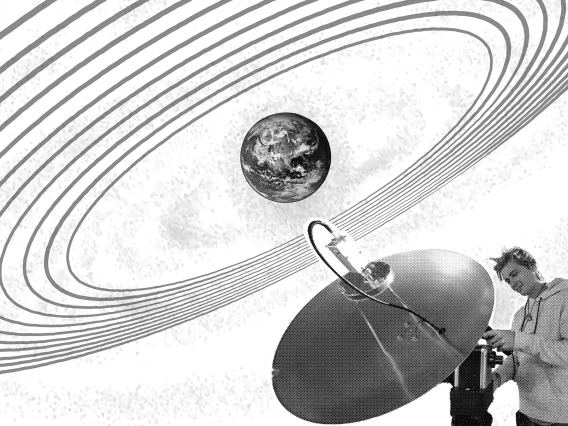
Space4
More than 28,000 human-made objects including satellites, spent rocket bodies and mission-related debris currently orbit Earth. And with up to 100,000 new satellites projected to launch in the next decade, the growing congestion poses serious hazards for astronauts and spacecraft amid a new era of lunar missions. The Space 4 Center creates and implements research and education solutions that ensure space remains safe, secure and sustainable for decades to come.
Research and Applications
- Cislunar Space Monitoring: The space between Earth and the moon, called cislunar space, extends about 2.66 million miles from Earth—far past the distance within which the U.S. government currently tracks objects in space. Space4 researchers detect, track and identify human-made objects in space, from low-Earth to cislunar orbit, to support space surveillance, traffic management, and national security.
- Workforce Development: Focusing on training undergraduate and graduate students for careers in industry, government and academia
Fun Fact
The "Cone of Shame" isn't just a pet’s post-surgery collar—it's also an astronomical blind spot. The bright glare of the full moon makes spotting space objects difficult, like finding a firefly near a floodlight. Despite this, the Space4 Center recently tracked a school bus-sized Chinese spacecraft deep within the Cone of Shame!
GCRB Research in the News
Acoustics
How topological acoustics can help us better understand a warming climate
U of A researchers are using topological acoustics, the study of sound wave behaviors in complex structures, to gain insights into climate change, helping to better understand and predict the impacts of a warming climate.
French scientific agency selects Pierre Deymier for prestigious fellow-ambassador role
New Frontiers of Sound (NFoS) Director Pierre Deymier has been selected as a fellow by the French Scientific Agency, recognizing his contributions to science and appointing him as an ambassador to strengthen international research collaborations.
Engineering
Civil engineering researcher looks to remedy inequities in traffic safety
A U of A civil engineering researcher is working to address inequities in traffic safety by developing solutions that aim to improve road conditions and reduce accidents in underserved communities.
$35.5M awarded to UArizona College of Engineering for tech center expansion
The U of A’s College of Engineering has been awarded $35.5 million from the Arizona Commerce Authority to expand its tech center, a move that will enhance the university's capacity for cutting-edge research and innovation in engineering.
Medicine
U of A College of Medicine – Tucson advances in US News Best Medical Schools rankings
The University of Arizona College of Medicine – Tucson has once again been recognized as one of the best medical schools in the nation by the U.S. News & World Report’s Best Graduate Schools for Medicine rankings. The college was recognized for its graduates strength, who are filling a national need for physicians in rural and health professional shortage areas.
Colleges of Medicine lead initiatives focused on anti-racism in medicine
U of A’s Colleges of Medicine are leading new initiatives focused on anti-racism in medicine, aiming to address systemic inequities in healthcare and promote more inclusive medical practices.
Optical Sciences
Freeze-frame: U of A researchers develop microscope that can see electrons in motion
U of A researchers have developed a groundbreaking microscope capable of capturing electrons in motion, providing unprecedented insights into the behavior of matter at the atomic level.
Good vibrations: New tech may lead to smaller, more powerful wireless devices
U of A scientists have developed a new technology that harnesses vibrations to create smaller and more powerful wireless devices, potentially revolutionizing the design and efficiency of future electronics.
A new method for creating 3D images
U of A researchers have pioneered a new method for creating 3D images, offering a more efficient and detailed approach to visualizing complex structures, which could significantly impact fields like medicine and engineering.
Quantum
CQN Faculty Tapped to Lead New Journal
Members of the Center for Quantum Networks (CQN) including U of A Associate Professor of Optical Sciences Matthew Eichenfield have been selected to lead a new journal dedicated to advancing the field.
University of Arizona quantum technologies to generate $220m for the region
According to a report from Rounds Consulting Group, U of A’s advancements in quantum technologies, led by the Center for Quantum Networks, are projected to generate an estimated $220 million for Southern Arizona over the next decade.
Space
UArizona’s Space4 Center Part of International AI Space Sustainability Project
The U of A’s Space4 Center is part of a $1.9 million international collaboration exploring how artificial intelligence (AI) can be harnessed to improve space operations, safety and sustainability. The project will accelerate the development of AI technologies from concept to adoption in the space sector.
University of Arizona project improving space safety through AI
Roberto Furfaro, U of A systems and industrial engineering professor and Space4 Center deputy director, is part of an international partnership using artificial intelligence to help predict and avoid collisions with space debris.
Taking Law to the Final Frontier
A new U of A course launches students into an emerging legal frontier: space law. Co-taught by faculty in the James E. Rogers College of Law and the College of Science, the course introduces students to issues raised by human activity in outer space, including asteroid mining, space tourism, traffic management, communications satellites and national security.

"The Grand Challenges Research Building is a testament to fostering a culture of collaboration that results in real-world impacts. The GCRB allows us to further expand our research capabilities and to attract partners in industries such as biomedicine, engineering, and optical science. We are excited about the scientific and technological breakthroughs that will take place here."
—Elliott Cheu
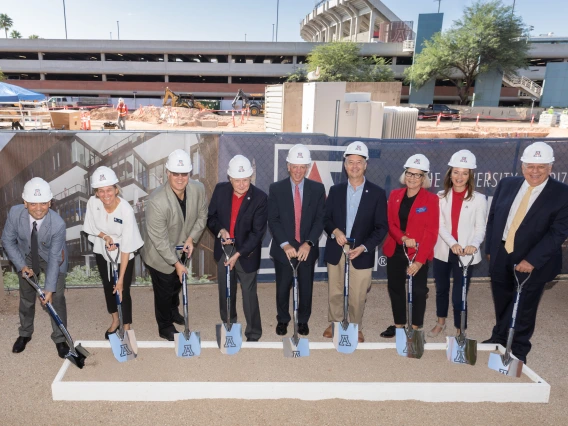
In the News
September 28, 2021
Construction Underway on University's Grand Challenges Research Building
Research and centers located in the GCRB:
UArizona faculty, staff, and students across all disciplines work to unlock new research solutions and accelerate breakthrough discoveries using the power of information technologies enabled by The Institute for Computation and Data-Enabled Insight (ICDI) and other data-related units that will be housed at GCRB.
At UA major research is ongoing related to the development of advanced optical microscopes, endoscopes, and micro-endoscopes. Several faculty members are involved in multi-modality imaging (optical, MRI, ultrasound, photoacoustic, nuclear) which is a technique that enables scientists to study the microenvironment of a tumor.
Optical sciences research includes the use of lasers, lenses, spectrometers and other light-manipulating systems to design equipment for manufacturing, medicine, communications and space exploration. GCRB will greatly expand UA’s capacity in optical sciences, below are two areas that highlight UA’s research potential. The College of Optical Sciences has over 50 active research programs and generates approximately $20 million in new research awards per year.
In August 2020 the NSF selected UA to lead and establish the Center for Quantum Networks. The quantum approach to computing is new to the physics of transferring information, it merges quantum mechanics and information theory. Quantum computing is expected to transform medicine, break encryption and revolutionize communications and artificial intelligence. In addition to developing the quantum internet, the Center is charged with creating the curriculum for the new discipline, “quantum information science and engineering.”
Researchers at UA are world-leaders in designing and fabricating highly specialized optics. Students work alongside faculty on projects of global significance, such as the Giant Magellan Telescope, the Large Synoptic Survey Telescope, and OSIRIS-REx.
Established in 2023 with a $30 million grant from the National Science Foundation, NFoS is poised to revolutionize technology, transforming everyday life. Partnering with top-tier institutions like Caltech, UCLA, and the University of Colorado Boulder, the center conducts cutting-edge research in topological acoustics—a rapidly growing field focused on innovatively manipulating sound waves.
The first floor of GCRB will include large multi-functional space intended to support student engagement and will be capable of supporting some instructional activity. The GCRB will house the state-of-the-art equipment and technologies required to successfully carryout the research detailed above.
Technologies:
Many large air-tables are required to provide the space and stability needed to conduct most optical experiments.
Laser systems drive most optical experiments and have specific power, cooling, shielding and other related requirements.
The facility will have at least one quantum networking testbed and specialized equipment for quantum network element prototyping.
There will be smart spaces hardware prototyping and human testing laboratories Remote sensing prototyping laboratories, and biomedical optics hardware prototyping laboratories.

